TWO CONDUCTORS: ANTONIA BRICO and MARIN ALSOP | |
Antonia Brico (1902 - 1989) Conductor, pianist, music educator The first female conductor to achieve international fame "You're either born a musician or you're born not a musician. It has nothing to do with gender." -- Antonia Brico | 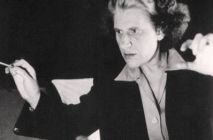  |
Marin Alsop (1956 -- ) Conductor, violinist, music educator The first female Music Director of a major U.S. orchestra (Baltimore Symphony) "Marin Alsop is one of the finest conductors on the planet." -- British music critic | 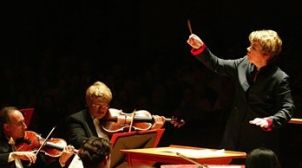  |
ANTONIA BRICO 1902 -- 1919 A DIFFICULT CHILDHOOD | |
Antonia Louisa Brico was born in Rotterdam, Holland in 1902, of Dutch and Italian parentage. Her mother, Antonia Shaaken, was in her teens and unmarried. Her father, Johannes Brico, was a pianist. Abandoned by her lover and shunned by her Catholic family, Shaaken put her baby in foster care with Mr. and Mrs. John Wolthuis. When Shaaken later tried to get her daughter back, Mr. and Mrs. Wolthuis took the child and fled to the United States. [1A] In 1907, they settled in Oakland, CA, where Antonia attended school as Wilhelmina Wolthuis, the name her foster parents had given her. The Wolthuis home was not a happy one. Because of her foster mother's frequent beatings and scoldings, Wilhelmina was an anxious child and began biting her fingernails. [2A] She later said: “I’d dream about having an automobile accident in front of someone’s house just so they’d pick me up and be affectionate.” [6A] She began piano lessons at age 10 when a doctor suggested this remedy to overcome her nail biting. Soon she was performing at local churches and club meetings. Her dream of becoming a concert pianist changed when she attended a concert conducted by Paul Steindorff. Rather than limit herself to one instrument, she decided to become a conductor. She later said: “The orchestra to me is the greatest instrument. It is to the musician what the palette is to a painter.” [2A] After her high school graduation in 1919, Mr. and Mrs. Wolthuis revealed they were not her birth parents. Antonia moved out and had no further contact with them. [2A] | 1907 Prices Bread: .05/loaf Milk: .31/gallon Car: $500 House: $4,500 Average Income: $897/year President Theodore Roosevelt Hot toy: Teddy Bear Top Books: The House of Mirth, Edith Wharton; The Secret Agent, Joseph Conrad Classical Music Premiers: Briggs Fair (Frederick Delius); Symphony of a Thousand--#8 (Gustav Mahler); Pomp and Circumstance (Sir Edward Elgar) Amy Marcy Beach (1867-1944) was recognized as a serious composer after the Boston Symphony premiered her Gaelic Symphony (1896); and Piano Concerto in C-sharp minor, (1899) with Beach as soloist. |
MARIN ALSOP 1956 -- 1973 BORN WITH A JOB
| |
Born 54 years after Antonia Brico, Marin Alsop was born in New York City in 1956. Her parents, Ruth and LaMar Alsop, were professional musicians. LaMar, a violinist, was concertmaster of the NYC Ballet Orchestra. Ruth played cello in the same orchestra. “I was born with a job!” Marin says. “My parents ... could never imagine a life for their child that was not filled with music!” [1M] She began piano lessons at age 2 and violin studies at 5. At age 7 she entered the Pre-College Division at Julliard. For a time during her teens she studied classical guitar. When she was 9, her father took her to a Leonard Bernstein Young People’s concert. It changed her life. “That was it for me. I absolutely knew that I wanted to become a conductor and never changed my mind.” [1M]. Her music teachers discouraged her. Her parents did not. They gave her a set of homemade batons. Her father has made all her batons ever since. [2M] Marin talks about this at http://www.marinalsop.com/media/ scroll down to First Woman conductor of a Major American Orchestra She entered high school at 12 (The Masters School) and in 1972, at the age of 16, she matriculated at Yale University (class of 1977). In 1975 she transferred to Julliard, to major in violin performance. [1M] | 1956 Prices Bread: $0.18/loaf Milk: $0.97/gal Car: $2,100 Gas: $0.31/gal House: $17,800 Average income: $5,341/year President: Dwight D. Eisenhower Top Books: Under the Net, Iris Murdoch; Notes of a Native Son, James Baldwin Classical Music Premiers: Candide, Leonard Bernstein; New England Tryptych, William H. Schumann; The Ballad of Baby Doe, Douglas Moore Bebe Barron and her husband Louis composed the first electronic musical score for film: Forbidden Planet (1956) [7M] |
ANTONIA BRICO 1919 -- 1932 A PASSION TO CONDUCT | |
Antonia enrolled at the University of California at Berkeley. As luck would have it, Paul Steindorff, the man who had inspired her conducting ambitions, was director of music and, more importantly, director of the San Francisco Opera. Antonia became his assistant. [4A] When she received a B.A. with honors in music in 1923, people advised her to teach. Conducting was no job for a woman, they said. But her ambition never wavered. [10A] She officially reclaimed her birth name, Antonia Brico, moved to New York City and studied piano with Sigismond Stojowski for two years. In 1926 she moved to Hamburg, Germany. Karl Muck, former conductor of the Boston Symphony, led the Hamburg Philharmonic. Armed with a letter of introduction, she persuaded him to become her mentor. She served as his apprentice for four years. At the same time she attended the conducting master class at the Berlin State Academy of Music, and became its first American graduate in 1927. [2A] But her personal life was in turmoil. Antonia went to Holland to reunite with her birth family and fell in love with an uncle who was nine years her senior. Their affair caused a scandal. Riddled with guilt, her uncle broke off the affair and returned to his suicidal ex-wife. [1A] | 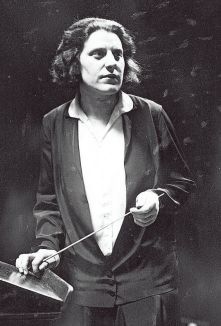  |
In 1930 she made her conducting debut with the Berlin Philharmonic, the first woman ever to lead that orchestra. Of her performance, the Allgemeine Zeitung critic said: “Miss Brico displayed unmistakable and outstanding gifts as a conductor. She possesses more ability, cleverness and musicianship than certain of her male colleagues who bore us in Berlin." [4A] Later that year, she guest-conducted the Los Angeles Philharmonic and the San Francisco Symphony. After a two-year tour of Europe conducting concerts with orchestras in Germany, Latvia and Poland, she returned to the United States in 1932 and settled in New York City. |
MARIN ALSOP 1975 -- 1990 MORE STUDY, EARLY PRIZES |
After earning a Bachelor of Music Degree in 1977 and a Master’s Degree in 1978 from Julliard, both in violin performance, Marin freelanced as a violinist. She performed with the NY Philharmonic, the NYC Ballet, NY Chamber Symphony, and the American Composers Orchestra. She also played Broadway shows (Sweeney Todd, Show Boat) and record dates, playing film scores, pop albums and TV commercials, which deepened her familiarity with American popular music. In 1979 she began conducting studies with Carl Bamberger. Eager to explore all types of music, in 1981 she organized a 10 piece all-string swing band, String Fever. In 1984 she founded the Concordia Orchestra, which performed jazz and contemporary repertoire in the New York City area. At the time, Marin said, playing jazz "has been tremendous for my conducting."
She continued her conducting studies with Harold Farberman in 1985. Three years later, in 1988 her hard work paid off. She was appointed Associate Conductor of the Richmond (VA) Symphony. She then won a Leonard Bernstein Conducting Fellowship to Tanglewood, where she studied with Leonard Bernstein, Gustav Meier and Seiji Ozawa. She was also a prize winner in the Stokowski Conducting Competition with the American Symphony Orchestra in NYC. [1M] In 1989 she was appointed Music Director of the Eugene (Oregon) Symphony and the Long Island Philharmonic, posts she held for seven years. Returning to Tanglewood in 1989, she was awarded the Koussevitsky Conducting Prize, the first and only woman awarded that honor. In 1990 she guest-conducted the Philadelphia Orchestra and the Los Angeles Philharmonic. [1M] |
ANTONIA BRICO 1932 -- 1940 BORN 50 YEARS TOO SOON! |
In January 1933 Antonia made her NYC conducting debut with the Musicians’ Symphony Orchestra at the Metropolitan Opera House. The Pictorial Review critic wrote: “With only three rehearsals Miss Brico made that orchestra play as it had never played before.” [2A] She was hired to conduct a second concert, but was denied a third when the tenor soloist, John Charles Thomas, refused to perform with a female conductor, fearing this would take attention away from him. [5A] |
In 1934 she founded the New York Women’s Symphony. She wanted “to prove that women could play in any part of the symphony--they can play equally well the trombone, the flute, the oboe or the French horn.” [8A] With support from Eleanor Roosevelt and NYC Mayor Fiorello LaGuardia, they played their first season in 1935, garnering excellent reviews. Renamed the Brico Symphony Orchestra for its 1938-1939 season, the group added male musicians but was forced to disband after one season due to financial difficulties. Photo at right: Antonia in 1938 with Mayor LaGuardia (left) and San Francisco Mayor Angelo Rossi (right) In 1936, she conducted the premier of Elinor Remick Warren's The Harp Weaver in Carnegie Hall. But lacking a permanent conducting job, she had to teach to support herself. For a time the child prodigy pianist and composer Phillippa Schuyler was her pupil. | 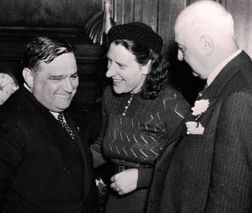  |
Then came a plum assignment. In 1938 Antonia became the first woman to conduct the New York Philharmonic Orchestra in a concert at Lewisohn Stadium. The Sibelius Symphony #1 was on the program. While in Europe, she had contrived to meet Sibelius, who became her mentor. Her passion for his music led him to declare her the only conductor who interpreted his work as he intended it to be performed. [1A] The NY Times critic praised her interpretation of the Sibelius which “. . . brought one of the most spontaneous and sustained outbursts of approval of the Stadium season.” The review went on to praise the “life, color and sanity of her readings [which were] expressed with effective verve and intensity.” [7A] Despite such positive reviews, a permanent conducting job in the United States continued to elude her. A comment made to her before her NY Philharmonic debut is telling: Mrs. Charles Guggenheimer, a wealthy socialite, said, "It's a disgrace that a woman is conducting this venerable orchestra." [4A] Arthur Judson, who managed the NY Philharmonic and the Philadelphia Orchestra, told Antonia, "All those females in the audience want to see a male conducting. Brico, you were born 50 years too soon." [4A] | |
MARIN ALSOP 1992 -- 2004 HONORS AND ACCOLADES
|
In 1992 Marin was appointed Music Director of the Cabrillo Festival of Contemporary Music (Santa Cruz, CA). Under her direction, the festival won the ASCAP Award for Adventurous Programming of Contemporary Music. Her European debut came in 1993 at the Schleswig Holstein Music Festival, conducting the music of her mentor, Leonard Bernstein. That year she was appointed Music Director of the Colorado Symphony. Under her direction, the CSO won ASCAP’s first prize for programming in 1996/97 and 1999/2000. In 1999 she became Principal Guest Conductor of the Royal Scottish National Orchestra (Glasgow) and began recording the complete works of Samuel Barber (a 6-CD series) for Naxos. [1M] A new century brought more honors. She became a major star in England when the Bournemouth Symphony Orchestra appointed her Principal Conductor for the 2002/03 season. Of her conducting, The London Times said, “Alsop ... made her orchestra play like there was no tomorrow.” | 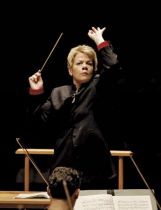  |
In 2003 she won Gramophone Magazine’s Artist of the Year award and the Royal Philharmonic Society’s Conductor Award, the first artist ever to win both major awards in one year. In 2004 she began recording a Brahms cycle for Naxos with the London Philharmonic Orchestra. She also led the first major US revival of Adam’s Nixon in China with the Opera Theater of St. Louis, and a semi-staged production of Bernstein’s Candide with the NY Philharmonic. See Marin conduct John Adams Short Ride in a Fast Machine Alsop conducts Adams |
ANTONIA BRICO 1940 -- 1971 A WOMAN WITHOUT AN INSTRUMENT | |
In 1940, Antonia visited Denver, Colorado. Jean Cranmer, whose husband had designed Denver's mountain park system, gave her a tour of one of the parks. The Denver Post ran a large photo of Antonia on the front page. Later that year she was invited to guest conduct the Denver Symphony Orchestra. Aware that the DSO was searching for a full time conductor, she made a point of telling Cranmer and other influential Denverites about her ties to Muck and Sibelius, and her fabled meetings with composers Igor Stravinsky and Richard Strauss. The DSO board invited her to guest conduct the DSO in Brahm's German Requium a few months later. Believing she had made the necessary contacts to win a permanent conducting post with the DSO, Antonia moved her music studio to Denver and rented a nearby apartment. | 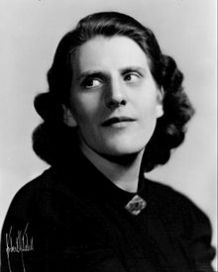  |
But in 1945, the DSO board awarded the conducting post to Saul Caston, associate conductor of the Philadelpia Orchestra under Eugene Ormandy. Ann Papp, who had reviewed Brico's concerts with the DSO for the Rocky Mountain News, said, "Brico was far better qualified than Caston, but personality was a factor. She was extremely intelligent and had a wonderful sense of humor. ... But she could be abrasive, even dictorial at times." [1A]
Europe was more appreciative of her talents. After WW II ended in 1946, she conducted concerts in Sweden, Austria and Holland. At Sir Adrian Bolt's invitation, she led the London Philharmonic in a Royal Albert Hall concert. Composer Jan Sebelius deemed her "a conductor of flame and fire" and invited her to conduct an all-Sibelius concert in Helsinki, Finland. [2A] In 1947 a group of amateur musicians invited her to lead the Denver Businessmen’s Orchestra, the only permanent conducting post Antonia ever held. From 1947 until 1981, she led the orchestra in five performances each year. Throughout the 1950s and 1960s she toiled in obscurity in Denver. In 1967 the musicians renamed the orchestra the Brico Symphony in her honor. Although she appreciated this, it must have been cold comfort to a woman who had won rave reviews for conducting the Berlin Philharmonic and other European orchestras. | |
MARIN ALSOP 2005: A BANNER YEAR ... AND A SOUR NOTE
|
In 2005, Marin Alsop was awarded a prestigious MacArthur Fellowship, given to US residents in recogniton of exceptional creative work, the only only conductor to receive the award. [1M] She also made history as the first female to be appointed Music Director of a major U.S. orchestra. Her job with the Baltimore Symphony Orchestra would begin in 2007. After the announcement, the BSO players' committee issued a statement expressing their disappointment at the "premature conclusion of the music-director search process." Articles in the New York Times and Washington Post praised Alsop's accomplishments with other orchestras in the US and Europe, but raised the gender issue. [4M] Marin released a statement saying, "I look forward to making music with the exceptional musicians of the Baltimore Symphony Orchestra." She then called for a private meeting with the orchestra and flew to Baltimore. At a rehearsal she presented her vision for the future. The musicians were intrigued by her ambitious plans to reinvigorate the orchestra. [2M] At that time the orchestra was mired in debt, had not issued a new recording in almost a decade and often played to half-empty houses. [2M] | 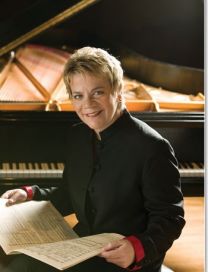  |
Broadcast live on XM satellite radio, her inaugural concert as Music Director of the Baltimore Symphony in 2007 won glowing reviews. Her innovative approach of telling concert-goers about the composition to be played and inviting prominent composers to discuss their music won her enthusiastic audiences. [2M] She quickly gained rapport with the Baltimore musicians, who found her energy and enthusiasm contagious. The orchestra made its first recording since 1999. Their first Alsop-led CD hit the top of the Billboard Classical Music chart when it was released in 2007. [2M] That year the Baltimore Symphony announced a 16% increase in new subscription sales over the previous year, and a more than 40% increase over 2005. [1M] | |
ANTONIA BRICO 1971 -- 1989 YEARS OF OBSCURITY, BRIEF SHINING MOMENTS
At right: Antoina conducts the Brico Symphony in Denver | 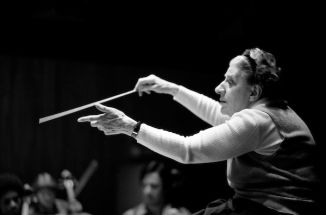  |
In 1971, folk singer Judy Collins decided to film a documentary about Antonia. As a Denver teenager, Collins had studied piano with her and in 1952 performed as piano soloist with Brico’s Denver Businessman's Orchestra. Although Collins' later success came in a different area of music, the two women remained close. [6A]
“Antonia: A Portrait of the Woman,” co-produced by Collins and Jill Godmilow, was released in 1974. Critic Marjorie Rosen called it "an extraordinary portrait of an extraordinary woman ... a pioneer female orchestra conductor ... an artist and feminist. ... [The film is] a vision of optimism and courage [that defines] a life of brilliant but thwarted promise. [It] is disturbing because it details brilliance misused; brilliance regarded as novelty. But ultimately it's uplifting because optimism and commitment and courage ... have a way of renewing and intoxicating us." [6A] The film demonstrates Brico’s indomitable will, unshakable determination and sense of humor, but in one poignant scene she laments: “I have five performances a year, but I’m strong enough to have five a month! It’s like giving a starving person a piece of bread.” [6A] The film won critical acclaim and an Academy Award nomination, which briefly revitalized Brico’s career. During the 1975-76 season she conducted two concerts at the Mostly Mozart Festival in New York City, her only performances preserved on record (see discography). She guest-conducted concerts with the National Symphony at the Kennedy Center, the Denver and Seattle symphonies, the American Symphony Orchestra, and concerts in Manila and Halifax. [4A] Her last New York appearances were in 1977 with the Brooklyn Philharmonia. [10A] In 1981 Antonia retired from conducting at the age of 79, but continued to teach. In 1988 she broke her hip in a fall. She died in a Denver nursing home on 3 August 1989 at the age of 87. [2A] MEMORIES OF ANTONIA Dan Frantz remembers The Gaze, a piercing, dark-eyed stare, as vivid in 1995 as it was three decades ago when he first saw Antonia. In junior high school he heard his band director play in the Brico Symphony. He recalls a short yet imposing woman walked on stage clutching a baton. He'd never seen a woman conduct an orchestra. "She wore this huge, black, flowing gown," Franz said. "And she had this stern look on her face that could have melted parts of Greenland." [1A] Henry Heskett played horn in Brico's orchestra for twenty years and remembers her disturbing mix of genius and childlike behavior. "She was a child ... in every respect except music," Heskett says. "She knew how to maneuver people. You knew you were being maneuvered, but you did it anyway." [1A] Wes Blomster, who now reviews classical music for the Boulder Daily Camera, recalls a concert in 1967, Brico's first opportunity to conduct the Denver Symphony Orchestra since the DSO board had snubbed her twenty years earlier. Her reading of Beethoven's Third Symphony swept him out of his chair. "That was one of the greatest Beethoven performances I've ever heard." But when he went backstage, he was astounded to discover the musicians did not share his opinion. Some of them later circulated a petition demanding that Brico never be allowed to conduct their orchestra again. "The orchestra hated her," Blomster says. "Their minds were made up." [1A] For Elizbeth Jans, Brico's housekeeper/secretary and closest companion in her final years, what stands out is Brico's iron-willed determination. "She was very tenacious," Jans says. "If she wanted something, she went after it--even if she had to go to Finland or Africa. If you told her she couldn't do something, she would be even more determined." [1A] |
MARIN ALSOP 2008 -- 2015 ONWARD AND UPWARD
| 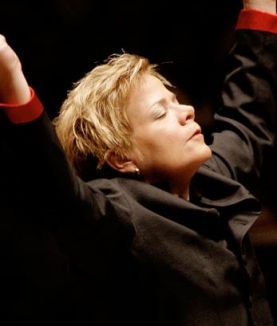  |
In 2008, Marin led the Baltimore Symphony Orchestra in its Carnegie Hall debut. That year she lauched an innovative educational program in Baltimore. OrchKids provides music education, instruments, meals and mentorship to some of the city's neediest young people. See photos below. For more information about the program see OrchKids | |
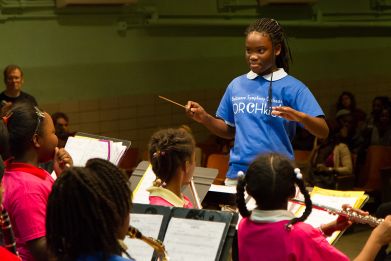  | 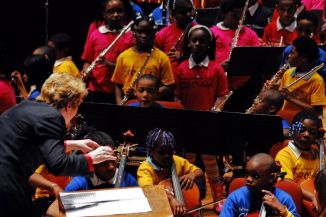  |
In 2009, her critically acclaimed Naxos recording of Bernstein's Mass was nominated for a Grammy Award for Best Classical Album. In 2010 she conducted the piece at London's Southbank Centre to conclude her 9-month-long Bernstein Project. The next year she became Artist in Residence at the Southbank Centre for the 2011/2012 season. In 2012 she was appointed Principal Conductor of the Sao Paulo Symphony Orchestra. She led the orchestra on a European tour with acclaimed performances at the BBC Proms in London and at the Concertgewouw's summer concert programs in Amsterdam. Hear Marin conduct the orchestra in Copland: Fanfare For the Common Man Alsop conducts Copland In 2013, the Baltimore Symphony renewed her contract as Music Director for the second time, extending it until 2021. Sadly, Marin's parents, Ruth and Lamar Alsop, died within a month of each other in 2014. Marin conducted a memorial concert for them at Mannes College The New School of Music. See her commemorative video at CommemorativeVideo In 2015, Marin conducted the prestidgeous Last Night of the BBC Proms in London. Four students were awarded the Alsop Entrepreneurial Award, a prize funded by Marin and the Alsop Family Foundation. Her contract as Music Director of the Sao Paulo Symphony Orchestra was extended until 2019. She was appointed Director of Graduate Conducting Program at the Johns Hopkins Peabody Institute. These are only a few of Marin's accomplishments. To see more, visit her website. ALSOP WEBSITE |
COMMENTARY OBSTACLES: During Antonia Brico’s lifetime, symphonic conducting was a male preserve. Early in her career Brico mastered the standard orchestral repertoire and won the support of conductors Karl Muck, Sir Adrian Bolt and composer Jan Sibelius; reviews of her concerts were overwhelmingly positive. Even so, after an auspicious start, she sank into obscurity, regaining brief prominence only in the twilight of her years. Arthur Judson believed she was ahead of her time, born fifty years too soon. She died in 1989. Born 54 years after Brico, Marin Alsop received her first conducting post in 1988. For Marin, obstacles still existed, but by the time she entered Julliard in the 1970s the climate was changing. She also had supportive parents, who were professional musicians. Both women followed similar paths: performance on their instruments, intense conducting studies prior to their public performances as conductors; both established their own orchestras to gain conducting opportunites. Both had similar qualities: high intelligence, innate musical talent, a passion for music, great determination and above all a capacity for hard work. GENDER BIAS: Antonia felt the bias came from management, not musicians. In a 1975 interview, she said, “If the leader knows her business, the orchestra doesn’t care whether it is a man or a woman.” [3A] In 1976, she said, "The only sexists in the concert world today are women in the audience and most of the critics--they want only men on the podium." [4A] She promoted the talents of women composers, including the premier of Elinor Remick Warren's The Harp Weaver in 1936. Brico was ahead of her time. She believed more women would land orchestral jobs if auditions were held behind a screen to conceal their gender, an idea that did not take root until the 1970s. Marin prefers not to dwell on the issue, attributing some of her success "to the fact that I never interpreted any rejections as gender-based, even if I could have done so." Yet she also notes "There are more [opportunities for women] now than ever before, but it would be naive not to notice that there are no women music directors of any major orchestras in the world. [1M] In 2002 she started a fellowship for female conductors, the Taki Concordia Conducting Fellowship; each year one exceptionally talented woman is selected to work with Alsop and her orchestras. [1M] IMAGE: Concious of her image, Brico said in 1976, "Publicity is a strategic part of gaining some note for yourself." [4A] In 1975, she told a Newsweek interviewer, "Do you have to put in my age? When a man's gray, he's interesting. When a woman's gray, she's old." [3A] Alsop said in 2007: "A woman has to really think about how she gets sound out of the orchestra. If you want a really big dynamic range, you have to make a different gesture from a man, because otherwise people think you're trying to be this huge person and they get scared of that. You're a woman possessed. Or a bitch. Whereas in a man it's seen as strong." [6M] ROLE MODELS and MENTORS: Antonia Brico remains an inspiration for aspiring women conductors. Her mentors included Paul Steindorff, Karl Muck, Sir Adrian Bolt, and Jan Sibelius. Her spiritual mentor was Albert Schweitzer, with whom she studied Bach during the 1950s. Two prominent women became friends and supporters: Eleanor Roosevelt in the 30's; later, Judy Collins, her piano student and lifelong friend, paid tribute to her in a documentary film about her. Marin's parents were her greatest influence and encouraged her musical ambitions. Her mentor and hero was Leonard Bernstein. "He inspired me to become a conductor, became my mentor and teacher, and more than a hero could ever be!" She considers it an honor to be a role model for aspiring female musicians. "I am in a position to create opportunities for the next generation of women and I take that responsibility very seriously." [1M] She brings student groups onstage to perform with the Baltimore Symphony: a children's chorus, a university dance group, an inner-city high school drum corps. She established OrchKids to bring music to Baltimore's underpriviledged children. "I think art has the capacity to bring people together ... I think it can completely change the world in some way." [2M] LEGACY: Antonia Brico remains a towering figure, making her mark as the best known and most acclaimed female conductor of the early 20th century. In the 21st century, that torch has been passed to Marin Alsop, who continues to make musical news, thanks to her hard work, extraordinary talent and her passion to bring music to wider audiences young and old. |
DISCOGRAPHY: ANTONIA BRICO: Film: Antonia: A Portrait of the Woman, directed by Judy Collins and Jill Godmilow, 1974 Sony CD: Mozart Overtures, Divertimento, K. 131; Symphony # 28, 3/4/97 |
MARIN ALSOP: On YouTube! Marin conduct Too hot to Handel with the Baltimore Symphony Orchestra and the Morgan State Choir. Marin Alsop on the NewHour with Jim Lehrer (2007 interview) Discography: a sample of Marin Alsop's many recordings. Bournemouth Symphony: Naxos Compositions of John Adams and Busoni, 2004 Bartok: The Wooden Prince, 2008 Bartok: Miraculous Mandarin and other works 2005 Bernstein: Chichester Psalms and other works 2003 Colorado Symphony, NSS Music, with soloist Nadja Salerno-Sonnenberg, Violin Concertos of Clarice Assad and Tchaikovsky 2005 Royal Scottish National Orchestra, American Classics Series, 5 CDs Music of Samuel Barber, 2000, 2001, 2002, 2003, 2004, 2005 London Philharmonic Orchestra, Naxos, 4 CDs, 2005, 2007 Johannes Brahms' four symphonies, and other works New York Philharmonic Orchestra, Leonard Bernstein's Candide DVD: PBS Great Performances, 2005 Emmy Award finalist Baltimore Symphony Orchestra, Naxos, Dvorak, Symphony #9, 2007 |
SOURCES ANTONIA BRICO [numerals with initial A] 1A. The Brico Requiem, Alan Prendergast blog post 11-1-1995 2A American Lives: Volume Two: Notable Americans Who Died Between 1986-1990, Charles Scribner's Sons, 1999, Brico entry by Susan Fleet 3A. Current Biography 1948, Antonia Brico entry
4A. "Music, Maestra," Hubert Saal with Abigail Kuflik, Newsweek, 8-18-1975
5A. Opera News, February 1976, quoting Antonia Brico interview
6A. "Antonia Brico: The Orchestra is Her Instrument," Marjorie Rosen, Ms. Magazine Dec. 1974
7A. "Philharmonic Led by Antonia Brico," New York Times review, 7-26-1938
8A. "Antonia Brico Says Orchestras Not Prejudiced Against Women," Melita Spaggs, Christian Science Monitor, 11-13-1946 9A. Pictorial Review, Lloyd Morris, May, 1933 10A. "Antonia Brico, 87, a Conductor; Fought Barriers to Women in 30's," NY Times obituary, 8-5-1989
The Antonia Brico Collection is in the Library of the Colorado Historical Society in Denver, Colorado. ______ MARIN ALSOP [numerals with initial M] 1M. Marin Alsop website, www.marinalsop.com
2M. "Marin Alsop breaks the glass baton," Elaine F. Weiss, The Christian Science Monitor, 9-26-2007
3M. "The Maestro is a Woman," Newsday, May 2004 4M. "In hiring process, orchestra's conduct flawed," Richard Dyer, Boston Globe, 7-21-05 5M. "Beating time and space on the way to the top," The Telegraph (London) 3-22-2001
6M "I Don't need to be liked, I'd rather be respected," The Times (London) 2-9-2007 7M Excerpt from a book by Elizabeth Hinkle-Turner, Treasurer, Society for Electro-Acoustic Music, detailing Bebe Barron's achievements. |
© copyright 2008 Susan Fleet



